Fishing Trees & Standing Timber for Bass
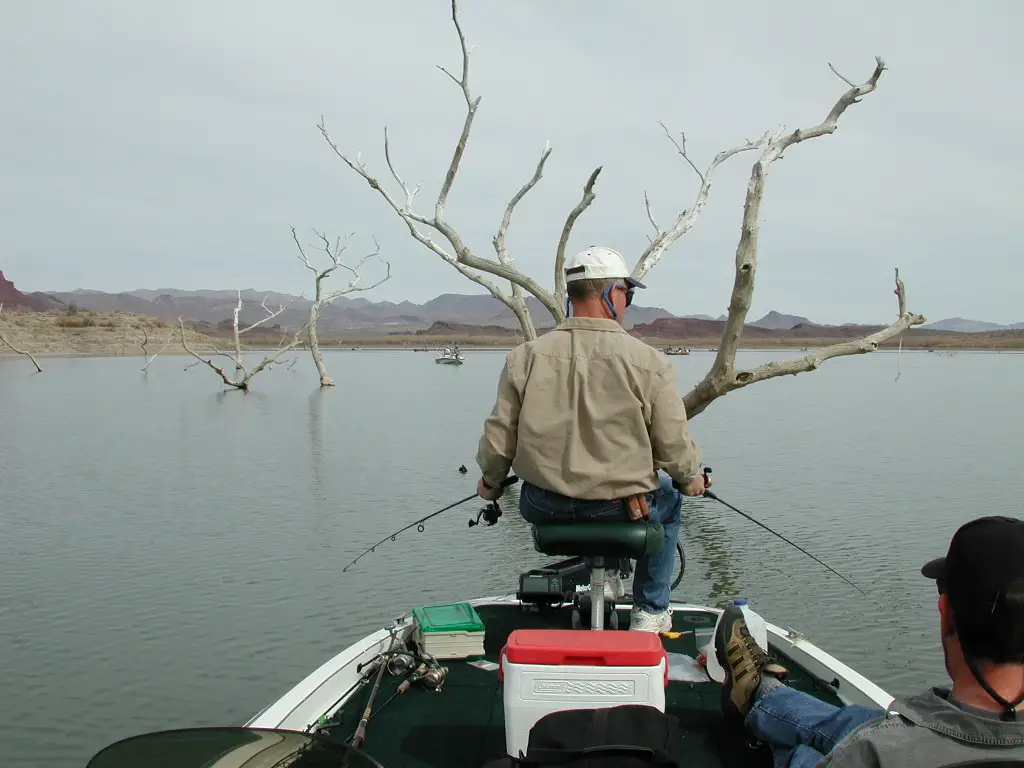
One thing is certain: not all trees are made the same.
You may be asking yourself, how do you fish a tree? The key to bass fishing trees and standing timber are: (1) looking for trees that have a greater likelihood to hold fish; (2) knowing when to fish trees throughout the year; and (3) understanding what baits work best.
Occasionally, if you visit any large lake you’ll see tons of trees… and… choosing where to start is overwhelming! And to make matters worse, most of the trees you’ll encounter may have the occasional fish near them, but the majority will have no fish at all.
To be blunt with you there are only two ways to become successful with fishing trees.
The old way is to spend hundreds (if not thousands) of hours on the lake fishing every single tree you come across – just hoping to catch a fish. But… for the majority of us we don’t have the time or the money to waste going that route, right?
The new way is to fish the trees in a surgical systematic way that can instantly give you the green light to start fishing and catching bass!
Now take a second to think about this… Can you imagine yourself having the confidence to pull up to any group of trees instantly know which ones should be fished or not? Can you see how many more fish you can catch in one day just knowing that? Wouldn’t that be awesome?
Heck yes it would!
Listen, If you ever got suckered into fishing all the wrong trees you know it can be similar to being in a barren ghost town… On top of that, it’s really frustrating wasting hours of your day, only to see other guys down the way jaw jacking huge bass!
In our fishing blueprint, we’re going to help you avoid all that… let’s get started…
Key Takeaways
Thankfully, bass fishing has become second nature to me now… but that wasn’t always the case. As I spent thousands of hours watching and learning from my mentors, practicing hundreds of hours on the lake… only to fail horribly…
However, over years of honing my skill whenever I had the chance, I slowly started to create my personal tree fishing blueprint for beginners, which is kinda-like my private set of strategies and tactics. Now whenever I get to the lake I use my same blueprint and I can quickly pick out the best locations that are most likely to hold fish… which allows me to avoid wasting hours of my fishing day… would you like to know more? Great, here are just some of the things in this blueprint you’ll learn how to fish standing timber for bass:
- Understand what trees types are more likely to hold fish… and… which to avoid as fast as humanly possible!
- How your PC can get you extra bites when you’re on the water!
- How you can legally check to see if the tree attracts bass… even if it looks like the hundreds of others in the area… you will get your answer in less than 1 minute… and helps you avoid spending countless hours on the wrong fishing spot!
- The single best way how to fish a tree… this strategy will allow you to catch all the fish… never worry about spooking the rest… even if fish jumps off your hook!
- Learn the best one-two punch for making bass bite when your fishing trees – even Mike Tyson would be proud!
But be warned! Go through this blueprint slowly and carefully so you don’t miss any tips that could cost you.
Tree Fishing Primer
Fishing trees (also known as vertical timber) may seem a bit challenging at first, but many successful anglers regularly fish these areas for bass. Why do they do this?
The main reason is that trees hold fish. Bass congregate around timber whether the lake has acres and acres of trees, as well as in other lakes that only have a few standing trees.
Helpful Tip: Vertical standing trees are ideal for bass because bass can move up or down with very little effort while hunting for prey.
The most common places to find standing timber in your lake will be on the main lake points with deep water close by.
You can find these points on a contour map or look for them on your fish finder, and you may be able to locate them easily by driving your boat around the lake.
Areas with flooded trees are very productive for fishing bass hiding amongst the branches. Finding a stump or two on a ledge is another productive place to fish bass on vertical timber. Head to the ledge you have found on your contour map with deep water nearby.
Step 1: Understand the Different Types of Trees
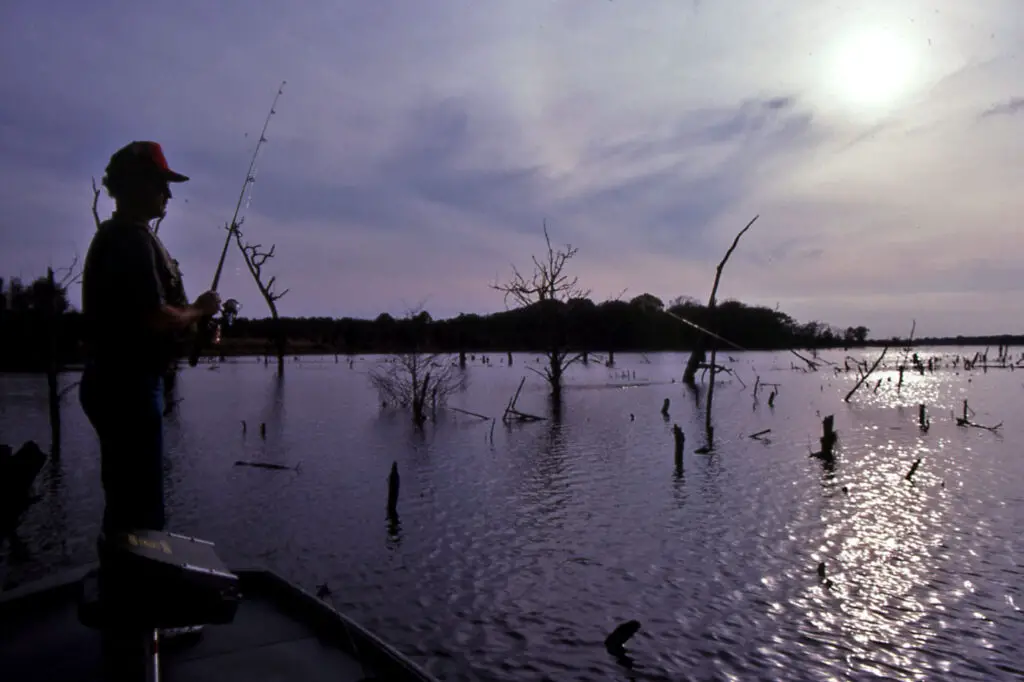
Exposed Vs Submerged
Any tree on the lake that hasn’t fallen over, and its roots remain firmly planted in the ground I call a ‘standing tree’.
When a lake is flooded during its creation the water level could completely cover any remaining trees with water. I call these trees, ‘submerged trees’.
Other times trees can be living in an area that is flooded naturally when heavy rains cause the lake level to rise, or if the tree is exposed and above the final water level after the lake is filled I call a ‘flooded tree’.
Next are stumps. I define a stump in bass fishing similar to the classic definition, the lower remaining portion of a tree that has been cut down. Sometimes during a lake’s creation the engineers will cut down the trees using the lumber for various construction products. The result is that the harvested areas are now filled with stumps. Stumps can be exposed or submerged.
Lastly, I included flooded brush and bushes. These will also fish very similar to standing trees especially if they are the only vertical structure in the area.
Laydowns are timber that has broken off and fallen into the lake. While they are also popular hiding spots where bass, since they are fallen they have been given their own category. If you want to learn more about fishing laydowns, I wrote a complete report called: Bass Fishing Laydowns [Complete System with Pictures], click here now to learn more!
Other Trees You May Encounter...
There are many tree species in lakes just as there are many kinds of trees on the ground. If cypress trees are abundant in your area, then you may encounter cypress trees in your lake.
Cyprus trees
Cypress and willow trees are popular spots for bass because they also hold various species of prey fish that are usually in the tree’s branches or around the trunk or under it.
A lake may have groups of thin trunks mixed in with a few broad trunks in vertical timber. Pine tree trunks are tall and thin whereas cypress trees are wider.
Helpful Tip: Since cypress trees grow in the water, they provide a lot of shade from branches and leaves. A cypress tree could be in the middle of a lake with a shady area on one side that is a cool resting place for bass to wait for bait fish.
Cypress trees usually grow in shallow water of around five feet with a lot of trees gathered into a tree grove or along the lake bank. Bass like to roam around the trees trying to find bait fish.
These trees grow roots that encircle the tree. This is referred to as the root ball, and a ridge develops under this root ball where bass can hide.
Many anglers do not know that the cypress tree also has another part called the knee where bass can hold on ridges below them. Knees are knots that grow on cypress trunks and are also a great hiding spot for bass.
Other Common Trees...
Willow trees are commonly found in western states in the country. They often have thick limbs and they grow close to the shore.
Other common trees include, but not limited to oak, ash, and pine, and are commonly located in lakes in the middle to upper United States. Any of these trees can hold bass, but bass much prefer willow and cypress trees.
Step 2: Find Quality Trees
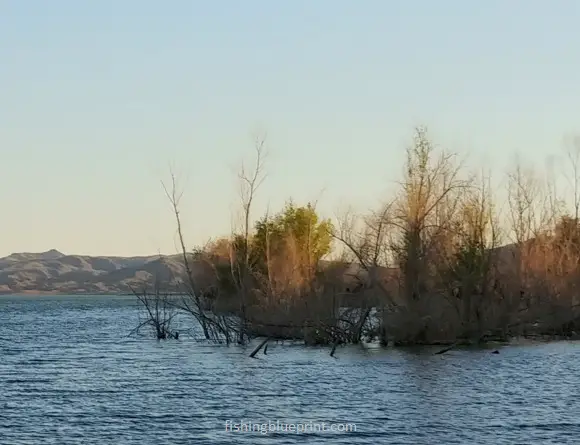
Unlike large topographic structures such as points, humps, or ridges, it can be very difficult to find trees… but it’s not impossible.
Here are two tools you can use at home to help you find trees before you get to the lake: Google Maps and Navionics Web App.
Google Maps can show you exposed standing timber in the lake if they trees are larger in size.
Navionics web app can show the topographic map of a lake and will have an area labeled as ‘flooded timber’.
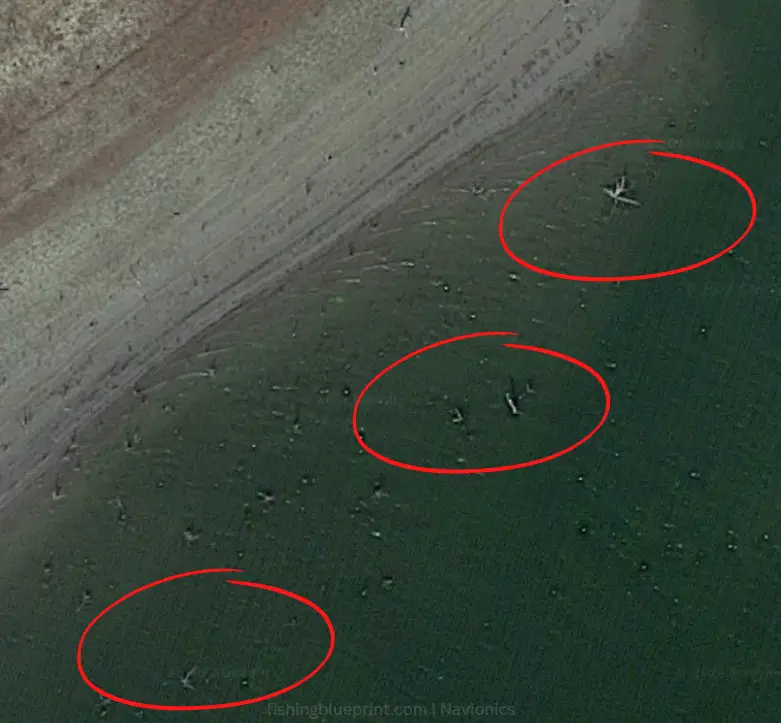
Look on the image from Google Maps. If you look closely you’ll see shadows these standing trees will produce. If it was a laydown you will not see these shadows.
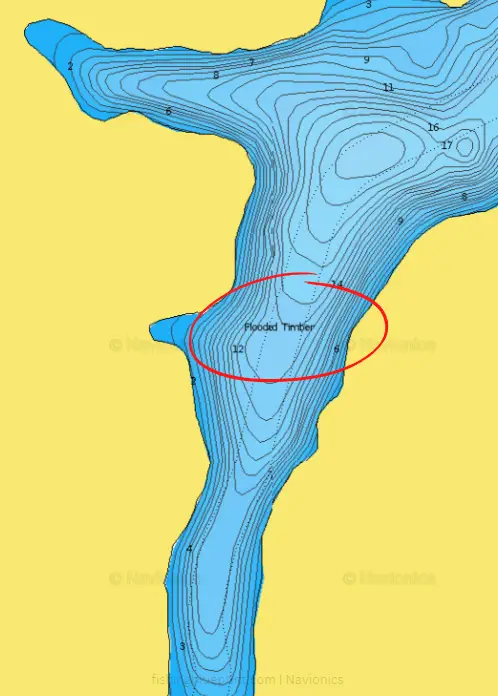
So what can you do next? Here’s the answer… find the best locations that are most likely to contain a trees and do a deep dive search in those areas.
Here are what I consider the 3 best locations to find trees for beginners to fish… please note… there are more locations to learn, but I don’t want you to be overwhelmed. With that being said, if you’re going to be bass fishing trees, these have a better than average chance of holding bass. And they’re going to be:
- (A) Backs of coves
- (B) Up river from the lake
- (C) Parallel the main river channel
(A) Backs of coves
In the backs of coves you’ll have a higher percentage to find and remaining standing timber if it was not harvested to help build the dam.
(B) Up river from the lake
If you travel up the river from the main lake you’ll note that the water gets relatively shallow. Many time you’ll start to see submerged or exposed timber
(C) Parallel the main river channel
If you don’t have a map with obvious markings, or you cannot find anything on Google Maps, then scan the main river channel of your lake.
However… don’t do what I used to do… do not scan the entire channel!
Depending on the water clarity and water temperature, scan between the depths of 15-60 feet to find trees.
Often if trees are 20-40 feet tall, then bass will hold over the tips of the trees.
Step 3: Identify the Trees With Your Fish Finder
Now that you are on the water it’s time to confirm the quality of the tree you are fishing. This step is really for trees that are in >6 feet of water.
Submerged trees are easy to find with a fish finder.
If the tree is less that a few feet of water it can be incredibly difficult to scan.
Step 1) If you are pulling up to a group of tree I strongly suggest starting with a side scan first and position your boat over deeper water.
Side imaging can show what is underwater on both sides of your boat, including 240-feet on either side of what is underwater on the left and right of your boat.
This fish finder feature will return a lifelike image of submerged timber and of other cover under the water. It will also show clear images of fish.
Larger fish such as bass show up as bright spots with shadows. Schools of bait fish are shown as clouds while bass look like white lines.
Although a fish finder side image clearly shows the fish, it is not as efficient at revealing what the submerged timber looks like besides its shape and approximate size.
Step 2) After you side scan the laydown, start scanning promising areas with your 2D and structure scan sonars.
Fish can easily be seen on a regular 2D sonar fish finder, but adding a CHIRP to your current device will help you to see standing timber more clearly. A 2D sonar fish finder can provide a clear picture of standing timber in your lake that looks like short lines in a vertical manner that resemble a tree trunk.
Some fish finders show submerged trees lit up so you can see them easier.
2D imaging shows you whether bass are located around or in a submerged tree. The fish may look arched, and the lunkers usually have a higher arch than smaller bass.
A 2D down scan image helps you confirm that you are in the spot where your contour map indicated that underwater standing timber was present in a certain area.
If an angler is looking for standing timber located on a ledge, 2D sonar will show them what the ledge looks like in detail. Then, they can look for standing timber on the ledge.
A downward structure scan also provides a clear picture of what the tree trunk or other timber looks like. It can show you what is underneath your boat, and it returns a clear picture-like image of the wood.
Down imaging provides the best, clearest pictures of the underwater timber.
The best pictures of down imaging are when it is combined with a side image. Underwater cover shows up clearly such as standing timber, rocks, weed piles and other cover.
Now if you did your homework you should have been able to find some trees on your lake. This example below is a group of trees that are located next to a channel. Obviously the lake is at a low level. I chose this image so you can trees.

So you get to the lake. Let’s say its at full pool and the trees are submerged. Start by side scanning the area…
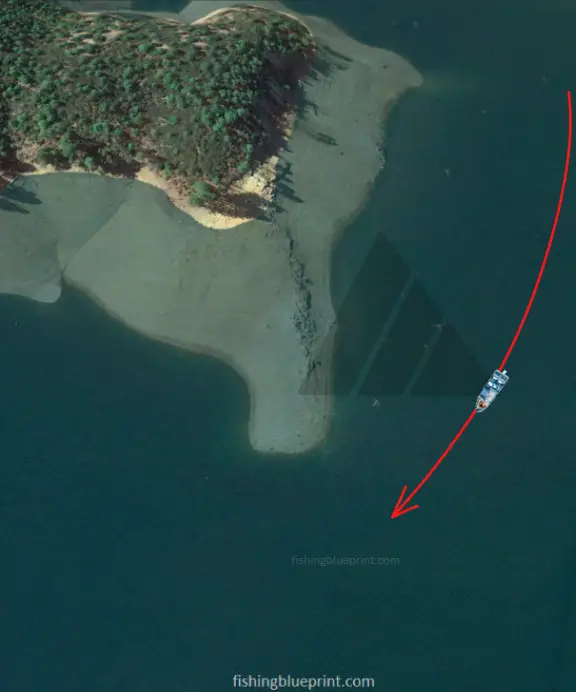
This is what it should look like with your side scan sonar (image below).

Your fish finder will also check the depth of water, water temperature, speed, and heading as you drive your boat over the lake.
If you see balls of bait you and the area looks like a good spot, then switch to you structure scan and 2D sonar
Start by driving back and forth over the tree.
Take note if there are any bait or bass that are located near the tree.
Schools of shad will appear like a group of small floating dots.
Bass will appear as arcs. Usually they are positioned in a horizontal line and do not stack up more than two or three fish above another one.
If you see more than 3 large arcs stacked on one another chances are they are crappie, white bass, or yellow bass.
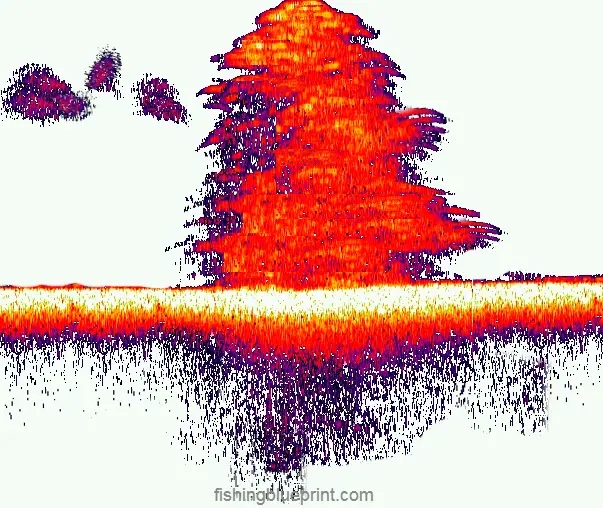
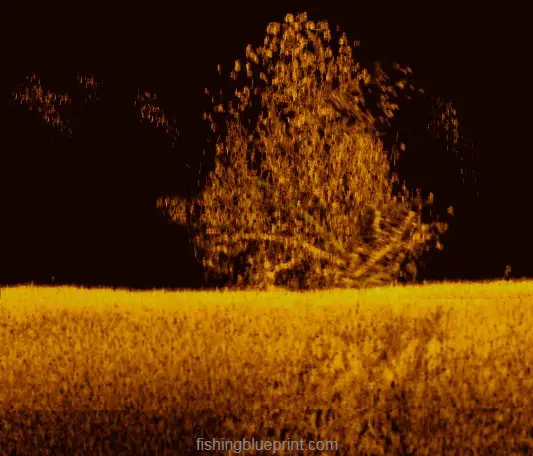
Finding Active vs. Inactive Fish
When scanning standing you want to see the bass on top, or very close to the tree. This signifies the bass are actively feeding. These fish are extremely catchable anytime they are relating directly on top or close to the base of the tree, best of all you can typically catch them using an assortment of lures.
Look at the images below. This is a downward scan image I recreated to show you what bass look like when they’re relating to the apex of the brush pile, they are the large arcs. The smaller dots represent baitfish like shad.
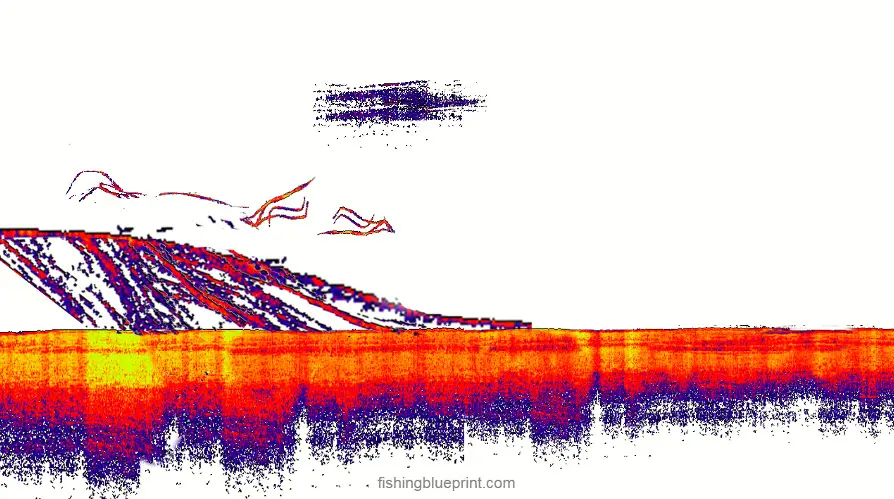
The bass will suspend above the deeper water, off to the side of the point are not actively feeding. As an illustration in the picture below, they are off to the side of the tree and are harder to catch.

Step 4: Fishing Trees Systematically
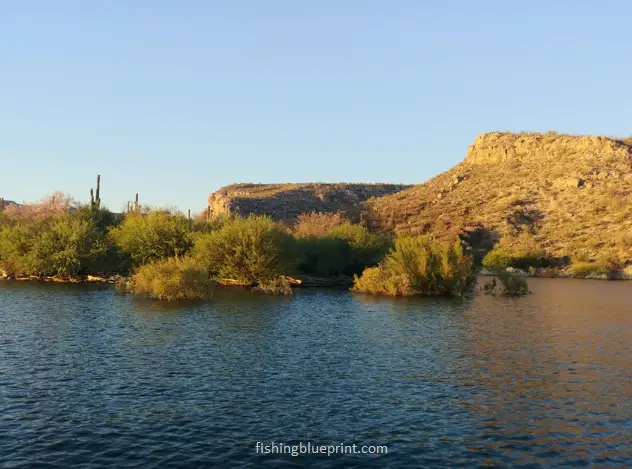
Below are some strategies for securing a sure bite when fishing trees…
1) Location, location, location. The right location is everything when fishing vertical timber. Before you hit the water make a milk run list of trees that you spot that have the best chances of harboring bass.
2) Closely dissect the first couple of trees you come across. Try to establish a pattern on where the bass are and what they will eat. You can quickly and easily do this by fishing the tree systematically. Once you get a pattern then you can focus on where the bass are most likely to be with other trees.
This is what I recommend doing… Start with fishing the outside of the tree first and focus on the external branches first.
If part of the tree is under water and you aren’t sure where the end is, try to visualize where other external branches could be and make your cast.
Once you’re done fishing the branches it’s time to fish the primary trunk of the tree.
Most of the time, the largest bass often hides close to the main trunk. It’s here they feel protected and can easily move out to ambush shad or bluegill.
You’ll probably catch a couple of smaller bass on the branches and the bigger ones close to the trunk. But don’t get complacent and lazy… sometimes the bigger ones will venture out to the external branches.
Helpful Tip: Great moving baits include spinnerbaits, Chatterbaits, swim jigs, weedless soft plastic swimbaits, underspin jigs, and squarebill crankbaits.
3) Start with using a moving bait. Moving baits should always be your first choice when fishing trees. Great moving baits include crankbaits, soft plastic swimbaits, spinnerbaits, Chatterbaits, jerkbaits, swim jigs, hair jigs, and underspin jigs.
Fishing the external branches by intentionally crashing the moving bait into the limbs and having it crawl up and over it is key to getting the fish to bite.
As you start to fish the trunk you can yo-yo a moving bait such as a swim jig up and down to elicit a bite.
4) Slow it down to pick off the more reluctant bass. Sometimes the bass doesn’t want to chase down a moving bait… That’s okay, do get frustrated… If that happens it will be time to slow it down.
Here are my top lures to fish a trunk slowly… tungsten flipping jigs, Texas rigged creature bait and a wacky rig Senko.
A tungsten flipping jigs are better than lead jigs because tungsten is a denser material than lead which means you get a heavier weight in a smaller package. Tungsten is nearly twice as hard than lead, and is about ½ the size of a lead jig,
The smaller sizes also means less drag… which also means it has a quicker fall rate for the same sized lead jig.
Lastly, since it’s more compact there is less chance for hangups.
My second or third choice for baits are going to be Texas rigged compact soft plastic creature baits for flipping. And yes, I’ll thread on a tungsten bullet weight for the same reason that I outlined above.
My third go-to bait is going to be a 4 or 5 inch stick bait (such as a Senko) rigged wacky style.
5) And finally, be stealthy. During the process of fishing a tree, especially if you’re starting to fish the main trunk, try to be as quiet as possible. Turn off the radio, keep your voice down, avoid any loud banging, walk softly so you don’t spook the fish. Do not rev your engines and maintain a steady rpm.
My Personal Notes: My 2 Biggest Problems with Fishing Trees
One of the biggest problems and frustrations I had when I first started with fishing vertical timber was not knowing where to start. I would see a very large area of trees and have no idea where to begin.
Because I was a newbie, I thought that it was best just to pick a tree that looks like it holds bass and start fishing there. This wastes a lot of time and usually does not lead to hooking into many bass.
It wasn’t until I really started to dive in and learn the art of fishing trees. I can give credit for learning the lessons taught to me by my cousin, Bill. He is one of the best tree fishermen you’ve never heard of… I call him the ‘tree whisperer’.
Helpful Tip: Another thing I’ve learned throughout the years is you can jaw-jack bass with or without a fish finder. If you do not have a fish finder, use a topographic map of the lake to study the lake bottom.
Just try to be aware of your surroundings and pick out the best locations to fish so you don’t waste your time.
Another frustration I had to come to terms with was realizing my is probably going to get scratched from trying to squeeze into groves of trees. Some anglers get back in the thick trees not knowing that they could damage their boat by doing this. It’s just part of this style of fishing.
So in summary, really I hope I was able to give you a tip or two… maybe leave you in a better position from where you started before reading my blueprint for fishing trees.
Take care and tight lines!
— George
Want To Learn Where To Catch More Bass? Checkout These Articles...
- Bass Fishing CREEKS The Easy Way (In Less Than 10 Minutes)
- Warning: Bass Fishing HEAVY GRASS? [15+ Mistakes To Avoid]
- Bass Fishing POINTS in 5 Quick & EASY Steps!
- Complete 5-Step DOCK Fishing Formula
- Bass Fishing LAYDOWNS [Complete Guide + Pictures]
- Little Known Pattern for Fishing TREES for Bass.. Now and Forever
- Complete Formula For BASS FISHING ROCKY BANKS & RIPRAP
- The 5 TRUTHS about Bass Fishing BRIDGES and Avoid Wasting Time On Techniques That Don’t Work!
- Bass Fishing BRUSH PILES To Catch The Most Bass In Minimum Time!
- The 7-step Secret Formula for Bass Fishing LEDGES – Even a Complete Fishing Noob Can Use and Be 100 Times More Potent Than the Best B.A.S.S. Professional!
- The Single Best Guide to Fishing SHELL BEDS… and… Do It Fast!
- 5 Basic Elements Of Fishing HUMPS AND RIDGES No One is Talking About!
- 5 Crucial (and Unusual) Tactics You Must Do When Bass Fishing ROADBEDS!
- Top 25 Summer BANK Fishing Tips (Never Get Skunked Again)
- [EXPERT REVEALS] Bass Fishing In MUDDY WATER Secrets – 27 Tips & Mistakes To Avoid Today!
- 31 Best Tips for Bass Fishing At NIGHT (Complete Guide)
Other Bass Fishing Articles Just For You...
Selecting Early Summer Bass Fishing Lures [Avoid 5 Common Mistakes]
A Complete Buyer’s Blueprint On The Best Early Summer Bass Lures On The Market Today! When it comes to bass fishing, choosing the right lure
Early Summer Bass Fishing [Avoid These 3 Sneaky Lies]
Learn these closely guarded secrets early summer bass fishing … and… dramatically boost your advantage over other anglers! Late spring to early summer bass fishing
Fear The Finesse? 7 Ned Rig Fishing Secrets Exposed!
Conquer the Fear of Finesse… and… Unlock the Potential Ned Rig Fishing – TODAY! Fellow Angler… Like most of you I’m pretty set in my
Fishing Spawning Bass [18+ Lures & Gear]
Get Ready For The Spawn Now When bed fishing, stealth is of the biggest essential tip. Instead of racing forward with a trolling motor, anglers
[2024 Editors Choice] Picking The Best Bass Fishing LINE For ANY Budget
What is the best bass fishing line? | What is a good fishing line for bass? The best type of bass fishing line is based
Drift Sock Basics – What It Is A Drift Sock & How To Use It [2024 Quick Start Guide]
What Does A Drift Sock Do? | Why Use A Drift Sock? photo cred: WLUK We’ve ALL been there… you work your butt off the

